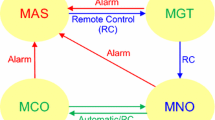Abstract
The microsatellite concept involves obvious limitations in size, weight, and on-board available power. This undoubtedly affects the design of the microsatellite subsystems, whose complexity has to be reduced to limit development times and costs. This paper deals with the analysis of the performance of the UNISAT attitude determination and control system. UNISAT is a joint project of a group of Italian universities aimed at designing and developing a multi-mission microsatellite for scientific and educational purposes. The attitude determination hardware consists of a miniature solid-state horizon sensor, a digital two-axis sun sensor, and a three-axis fluxgate magnetometer. Three-axis attitude control is performed with three magnetic torquers. Control laws are derived separately for the attitude acquisition and the stationkeeping phases using a linearized analytical model of the microsatellite attitude dynamics. Then, a numerical code, which simultaneously integrates the microsatellite orbital and attitude dynamics and control, is used to analyze the accuracy in the attitude angle determination from the sensor measurements and to test the effectiveness of the proposed control strategy for a range of sun-synchronous orbits and altitudes. Numerical results show that the proposed control techniques allow the satellite attitude acquisition to be performed in about one orbit and the attitude angles are controlled within ±2.5 deg during stationkeeping.
Similar content being viewed by others
References
OVCHINNIKOV, M. Y. “Simple Methods of Attitude Control For Small Satellites,” Paper No. IAA-95-IAA. 11.2.08, 46th International Astronautical Congress, Oslo, Norway, October 1995.
PARISSE, M., and TEOFILATTO, P. “UNISAT: Librations Passive Control Proposal By Using Fluid Ring Damper For a Gravity Gradient Stabilized Satellite on Eccentric Orbit,” 12th Congress of the ‘Associazione Italiana di Aeronautica ed Astronautica’ (AIDAA), Como, Italy, July 1993, pp. 1311–1322.
SIAHPUSH, A., and SEXTON, A. “A Study for Semi-Passive Gravity Gradient Stabilization of Small Satellites,” 1st USU Conference on Small Satellites, Utah State University, Logan, Utah, October 1987.
SIAHPUSH, A., and GLEAVE, J. “A Brief Survey of Attitude Control Systems Utilizing Momentum Wheel Concepts for Small Satellites,” Conference Proceedings, 2nd Annual AIAA/USU Conference on Small Satellites, Utah State University, Logan, Utah, September 1988.
STIKLER, A.C., and ALFRIEND, K.T. “Elementary Magnetic Attitude Control System,” Journal of Spacecraft and Rockets, Vol. 13, No. 5, 1976, pp. 282–287.
ALFRIEND, K. T. “Magnetic Attitude Control System for Dual-Spin Satellites,” AIAA Journal, Vol. 13, No. 6, 1975, pp. 817–822.
SHUSTER, M. D., and OH, S. D. “Three-Axis Attitude Determination from Vector Observations,” Journal of Guidance, Control, and Dynamics, Vol. 4, No. 1, January–February 1981, pp. 70–77.
Data Sheets from Space Hardware & Services CD-ROM, ICAP International, Longmont, CO.
MOCCIA, A., VETRELLA, S., and GRASSI, M. “Attitude Dynamics and Control of a Vertical Interferometric Radar Tethered Altimeter,” Journal of Guidance, Control, and Dynamics, Vol. 16, No. 2, March–April 1993, pp. 264–269.
PAL, P. K., and FOX, S. M. “The Effects of Momentum Bias on a Gravity Gradient Stabilised Spacecraft with Active Magnetic Control,” Conference Proceedings, 6nd Annual AIAA/USU Conference on Small Satellites, Utah State University, Logan, Utah, September 1992.
LEFFERTS, E. J., MARKLEY, F. L., and SHUSTER, M. D. “Kaiman Filtering for Spacecraft Attitude Estimation,” Journal of Guidance, Control, and Dynamics, Vol. 5, No. 5, September–October 1982, pp. 417–429.
GRASSI, M., VETRELLA, S., and MOCCIA, A. “Preliminary Design of the Attitude Control System of a Micro-Satellite for Earth Observation,” Space Technology, Vol. 15, No. 4, 1995, pp. 223–230.
WERTZ, J.R. (editor) Spacecraft Attitude Determination and Control, D. Reidel Pub. Co., Boston, 1978, pp. 779–786.
Author information
Authors and Affiliations
Rights and permissions
About this article
Cite this article
Grassi, M. Performance Evaluation of the UNISAT Attitude Control System. J of Astronaut Sci 45, 57–71 (1997). https://doi.org/10.1007/BF03546381
Published:
Issue Date:
DOI: https://doi.org/10.1007/BF03546381




